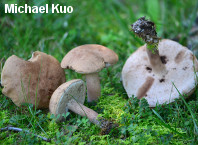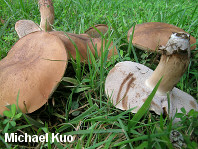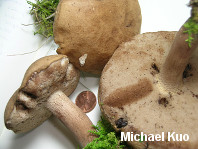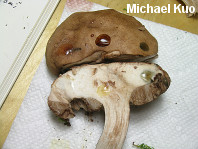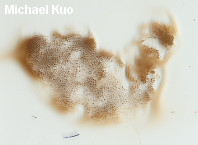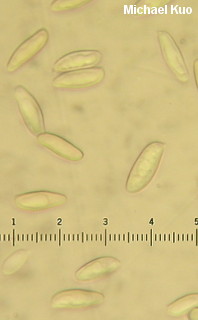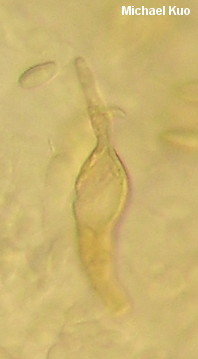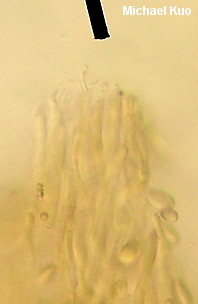| Major Groups > Boletes > Tylopilus > Tylopilus indecisus |

|
Tylopilus indecisus [ Basidiomycota > Boletales > Boletaceae > Tylopilus . . . ] by Michael Kuo Crucial identifying features for this oak-loving, eastern North American bolete include the pinkish mature pore surface, which bruises brown; the mild taste; the soft flesh; and the fairly equal (not club-shaped or swollen) stem that lacks olive shades and is whitish before discoloring on handling. It can bear a resemblance to Tylopilus felleus, but the latter grows under conifers, has a very reticulate stem, and tastes quite bitter. Other similar species include Tylopilus ferrugineus and Tylopilus badiceps, which have more highly colored stems. The California species going under the name "Tylopilus indecisus" (see Thiers, 1975; Desjardin, Wood & Stevens, 2016) is clearly not the species originally described by Peck from New York state in 1888; it is more robust, bruises much more readily, and possesses a much more reticulate stem. It is associated with coastal hardwoods, and probably represents an officially undescribed species. I have not collected it. Description: Ecology: Mycorrhizal with oaks, and possibly other hardwoods; growing scattered or gregariously; summer; widely distributed east of the Rocky Mountains. The illustrated and described collections are from Illinois and Kentucky. Cap: 5–11 cm; convex when young, becoming broadly convex or nearly flat in age; dry; very finely felty to bald; medium brown to tan. Pore Surface: Beige, becoming pinkish and, eventually, pinkish brown; bruising brown; pores circular to angular, 1–3 per mm; tubes to 15 mm deep. Stem: 3–7 cm long; 1.5–2 cm thick; more or less equal; whitish overall when young, developing brownish stains and sometimes becoming brownish with development; usually finely reticulate near the apex, but occasionally not reticulate; bald; basal mycelium white. Flesh: White; soft; staining pinkish to brownish in places when sliced. Odor and Taste: Not distinctive. Chemical Reactions: Ammonia negative on cap surface; negative on flesh. KOH dark red to dark gray or black on cap surface; yellowish to orangish on flesh. Iron salts blue-gray to gray on cap surface; negative to pale bluish gray on flesh. Spore Print: Brownish pink to pinkish brown. Microscopic Features: Spores 10–15 x 3.5–5 µm; smooth; fusiform to subfusiform; smooth; hyaline to yellowish in KOH. Hymenial cystidia 25–75 x 5–15.5 µm; fusoid-ventricose, often with long necks; hyaline to golden in KOH; smooth. Pileipellis a collapsing, tangled trichoderm; hyaline to brownish or golden in KOH; terminal cells cylindric with rounded or subacute apices, 2.5–5 µm wide. REFERENCES: (Peck, 1888) Murrill, 1909. (Coker & Beers, 1943; Snell & Dick, 1970; Smith & Thiers, 1971; Thiers, 1975; Smith, Smith & Weber, 1981; Weber & Smith, 1985; Both, 1993; Bessette, Roody & Bessette, 2000; Binion et al., 2008; Kuo & Methven, 2015; Desjardin, Wood & Stevens, 2016.) Herb. Kuo 08310101, 07140401, 08180603, 08271404. This site contains no information about the edibility or toxicity of mushrooms. |
© MushroomExpert.Com |
|
Cite this page as: Kuo, M. (2016, April). Tylopilus indecisus. Retrieved from the MushroomExpert.Com Web site: http://www.mushroomexpert.com/tylopilus_indecisus.html |
